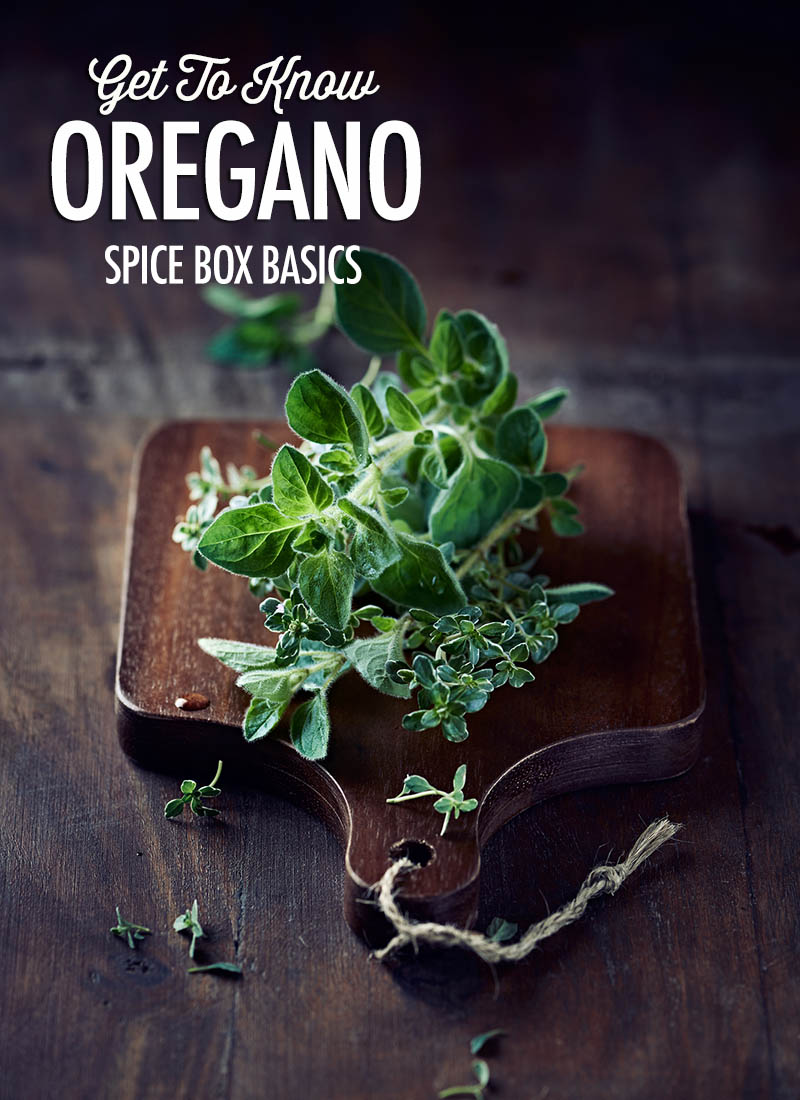Getting to Know Oregano is part of a monthly series here on FBC called The Spice Box. Primarily written by Michelle Peters-Jones, these articles create a spice primer for new and experienced home cooks alike!

Scientific Name of Oregano: Origanum vulgare
The first time I encountered the fragrant herb that is oregano, was in a small packet beside the chili flakes in my Domino's Pizza box in India. You won't believe how excited I was ... oregano. Now we grow it in our backyard, and every summer I curse it, as it grows too fast for me to use it like I want to. But thankfully, canning season is still here and oregano is beautiful in tomato sauce, canned tomatoes and salsa, so what better time to profile this intensely perfumed herb?
How to Grow Oregano
Oregano is a variety of herb from the mint family. It's also closely related to marjoram, and is sometimes called wild marjoram. It's a beautiful herb, with light grey and dark green soft leaves, and purple flowers. Native to temperate areas like the Mediterranean, Europe and parts of Asia, it's grown all over the world, but prefers warmer climates. Oregano is easy to grow in pots or straight in the garden. As a perennial it comes back every year, and is also beautiful as ground cover. Start oregano from seed, and plant in dry-ish soil and in full sunshine. It loves heat and will provide stronger flavoured leaves if planted later in the season when it's warmer.
I started my oregano from a plant cutting, and every year it comes back, strong and healthy, with its beautiful leaves. I avoid letting it flower, pinching off buds as they grow, and when the season is done I pick all the leaves off the plant and dry them in large bunches, hanging upside down in my cool larder. Sometimes, I will also pick oregano during high summer and dry the leaves in a flat wooden box, covered with chicken wire, out in the sunshine. Once the leaves are dry, I store them in sealed ziplock bags in a cool, dark and dry place, so I have a supply of herbs for the winter.
Flavour Profile of Oregano
Before talking about the flavour profile of oregano, it's important to note that there are two distinct varieties of oregano, European or Italian oregano and Mexican oregano, which are very distinct in their flavours. Unlike European oregano, Mexican oregano is related to the verbena family and the leaves are 'fluffier.' European oregano is sharp and peppery with hints of anise, while Mexican oregano is stronger and has citrusy flavours. Mexican oregano is rarely used fresh, it's almost always dried, while European oregano is used both fresh and dried. Dried oregano is stronger than fresh and, if substituting, it's best to use more fresh herbs than dried.
Culinary Uses of Oregano

Oregano is one of the most widely used herbs in Italian, Mediterranean, North African and Eurasian cooking. It can be used in all sorts of dishes, and is particularly delicious in tomato sauces. Oregano is one of the main ingredients in Italian seasoning blends, and pairs well with meats, fish and vegetables. Oregano does have a strong flavour and fragrance, though, so it's best used with caution, as it can overpower some of the more delicate dishes. It's also widely known as the 'pizza spice' for obvious reasons.
I use a good quantity of oregano in my Spicy Green Tomato Salsa, and it offers a beautiful, herby note to the spicy salsa. Oregano is also the star in Greek-style lemony roast potatoes.
Non-Culinary Uses of Oregano
Oregano has just as many non-culinary uses as it does in the kitchen. Oil of oregano is probably the best known, and it has been recommended for colds, coughs and asthma, as well as for heartburn and bloating. As with most herbal remedies, though, it's best to consult a physician before using. Oregano is also heavily used in the cosmetic industry and to flavour alcohol.
Oregano Trivia
And finally, did you know that 'oregano' literally translates to 'mountain joy'? Now that's romantic. Not so romantic is the fact that it was also originally used by Swedish mountain folk for flavouring ale and stopping it from going sour, but then again, anything that gives us good ale is great, right?
What have you created with oregano besides pasta sauces? Leave a link to a recipe on your blog in the comments so everyone can check it out!
Have a spice you’d like to see profiled? Let us know in the comments.
For more Spice Box profiles, check out Getting to Know Paprika, Getting to Know Dill or the whole Spice Box lineup.






I love oregano and hope my plant comes back next year. It was a lovely addition to this fresh tomato salad. https://tastespace.wordpress.com/2015/09/08/tomato-and-pomegranate-salad-with-fresh-oregano/